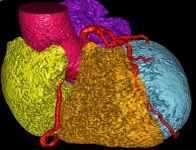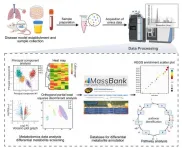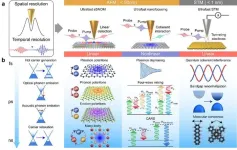(Press-News.org) CLEVELAND—Researchers at Case Western Reserve University, University Hospitals and Houston Methodist will harness the power of artificial intelligence (AI) to more accurately predict risk of heart failure and other cardiovascular events, including estimating when an adverse event might occur, by developing an AI model that “learns” from patient scans.
Cardiovascular disease is the leading cause of death worldwide, claiming over 17 million lives every year, according to the American Heart Association. Accurately identifying individuals at high risk remains a crucial unmet need. This initiative bridges the gap by developing advanced AI tools to analyze images from calcium-scoring computed tomography (CT) scans, a widely used diagnostic tool. The scans, which indicate how much plaque is in a patient’s arteries, also contain information about the aorta, heart shape, lung, muscles and liver.
The National Institutes of Health awarded two grants, totaling $4 million, to the collaboration to develop the AI model.
“This project represents a significant leap forward in personalized healthcare,” said project leader Shuo Li, a Case Western Reserve professor of biomedical engineering and computer and data sciences. “It has the potential to set new standards for cardiovascular disease prevention and management, as well as advance the forefront of using AI to analyze images for transformational healthcare.”
Innovative approach to predicting heart failure
The project creates AI-driven predictive models capable of interpreting combined data from calcium-scoring CT scans, clinical risk factors and demographics. Led by Li and Sadeer Al-Kindi, an imaging cardiologist and associate professor of cardiology at Houston Methodist DeBakey Heart and Vascular Center, the team aims to uncover deeper insights into the interplay between heart health and body composition. This would allow clinicians to identify at-risk patients with unprecedented accuracy.
“Accurate risk prediction allows us to tailor preventative treatments, reducing the burden of cardiovascular diseases and improving patient outcomes,” Al-Kindi said. “By identifying risk of heart failure and other events early, this project can potentially redefine care protocols, save lives and lower healthcare costs.”
Seamlessly adding AI to a clinician’s toolkit
By leveraging existing screening CT data in two large health systems (Houston Methodist and University Hospitals), this research underscores the potential of AI to address longstanding clinical challenges in a cost-effective and scalable way.
“Our goal is to develop a non-invasive, accurate and personalized method for predicting cardiovascular disease risk,” Li said. “This innovation will seamlessly integrate into existing clinical workflows, enhancing decision-making while minimizing the need for invasive diagnostic procedures.”
Using low-cost, non-invasive screening
A calcium-scoring CT is a low-cost, non-invasive heart scan that identifies how much calcified plaque is in the coronary arteries. The plaque in heart’s arteries can narrow or block them and can predict someone's risk of heart attack.
The AI model will learn to extract novel insights from CT images and use these measurements to estimate risk of cardiovascular events in large cohorts. These measurements include coronary calcium, heart shape, body composition, bone density and visceral fat in addition to age and other factors. AI can correlate outcomes with these risk factors much faster and more comprehensively.
“A clearer understanding of how these novel imaging-based risk factors combine will advance the knowledge of cardiometabolic disease phenotypes and support doctors in making appropriate and timely therapeutic recommendations,” said Sanjay Rajagopalan, a professor and director of the Cardiovascular Research Institute at the Case Western Reserve University School of Medicine and chief of cardiovascular medicine at University Hospitals Harrington Heart & Vascular Institute.
The research team includes other key contributors from diverse disciplines at Case Western Reserve: David Wilson, the Robert Herbold Professor of biomedical engineering and radiology and Pingfu Fu, professor of biostatistics in the Department of Population and Quantitative Health Sciences at the medical school.
###
At Case Western Reserve, one of the nation's leading research universities, we're driven to seek knowledge and find solutions to some of the world's most pressing problems. Nearly 6,200 undergraduate and 6,100 graduate students from across 96 countries study in our more than 250 degree programs across arts, dental medicine, engineering, law, management, medicine, nursing, science and social work. Our location in Cleveland, Ohio—a hub of cultural, business and healthcare activity—gives students unparalleled access to engaging academic, research, clinical, entrepreneurial and volunteer opportunities and prepares them to join our network of 125,000+ alumni making an impact worldwide. Visit case.edu to learn more.
END
Researchers harness AI to predict cardiovascular risk from CT scans
National Institutes of Health awards $4 million to Case Western Reserve University, University Hospitals and Houston Methodist
2025-01-14
ELSE PRESS RELEASES FROM THIS DATE:
Samsung takes top spot in U.S. patents for third year running while TSMC rises into second place; after four-year falloff, grants increase nearly 4%
2025-01-14
New Haven, Conn., Jan. 14, 2025—After four years of decline, U.S. patent grants headed upward, rising 3.8 percent from calendar year 2023 to 324,043 and Samsung retained the top spot for the third year in a row, according to IFI CLAIMS Patent Services, the world’s most trusted patent data source.
IFI CLAIMS Patent Services is a Digital Science company that compiles and tracks data from the U.S. Patent and Trademark Office (USPTO) and other patent-issuing agencies around the globe. IFI translates its world-leading data into an annual U.S. Top 50 and ...
HKU ecologist highlights critical gaps in global wildlife trade monitoring
2025-01-14
Wildlife trade poses one of the greatest threats to the survival of numerous species. According to the Intergovernmental Science-Policy Platform on Biodiversity and Ecosystem Services (IPBES) at least 50,000 species are involved in trade. However, while this figure already seems huge, it risks overlooking less traditional sectors of wildlife trade, such as the pet or fashion trade. For instance, recent data shows that the number of butterflies traded exceeds the total number of terrestrial arthropods in the IPBES assessment. This raises a critical question: How many ...
Smoking may lead people to earn less
2025-01-14
A new paper in Nicotine & Tobacco Research, published by Oxford University Press, finds that smoking has a negative effect on earnings among younger workers. This is particularly true among the less well educated.
The adverse health effects of smoking are well known. Smoking increases the risk of various cancers, respiratory issues, and cardiovascular diseases, with approximately 14% of all deaths in 2019 attributed to smoking. Despite smoking rates declining since the 1990s, in 2019 18% of women and 27% of men in high income countries still smoked.
Tobacco smoking has ...
Hiroshima flooding: A case study of well usage and adaptive governance
2025-01-14
Society is often vulnerable to disasters, but how humans manage during and after can turn devastation into opportunities for improved resilience.
For instance, private wells are attracting attention as an alternative resource for securing water for daily use and consumption in the event the water supply is cut off after a disaster. However, there are few records on how wells are used in the confusion of disasters, so detailed research is needed to promote the use of emergency wells.
Professor Takahiro Endo of the Graduate School of Sustainable System Sciences at Osaka Metropolitan University conducted a survey on the use ...
New survey finds over half of Americans are unaware that bariatric surgery can improve fertility
2025-01-14
St. Petersburg, Fla - Welcoming a newborn is something many couples dream of doing, but it can get complicated when conceiving becomes a roadblock. Infertility affects one in six people, but obesity can also be a problem. When diet and exercise aren’t enough to lose weight, bariatric surgery can become an option. Yet a new national survey by Orlando Health finds that 56% of Americans do not know that bariatric surgery is an effective way to improve fertility.
“Every day we have more patients ...
World’s oldest 3D map discovered
2025-01-14
Researchers have discovered what may be the world’s oldest three-dimensional map, located within a quartzitic sandstone megaclast in the Paris Basin.
The Ségognole 3 rock shelter, known since the 1980s for its artistic engravings of two horses in a Late Palaeolithic style on either side of a female pubic figuration, has now been revealed to contain a miniature representation of the surrounding landscape.
Dr Anthony Milnes from the University of Adelaide’s School of Physics, Chemistry and Earth Sciences, participated in the research ...
Metabolomics-driven approaches for identifying therapeutic targets in drug discovery
2025-01-14
This review is led by Professor. Tengfei Xu (Research Center for Clinical Pharmacy, College of Pharmaceutical Sciences, Zhejiang University) and Professor. Su Zeng (Research Center for Clinical Pharmacy, College of Pharmaceutical Sciences, Zhejiang University). The author emphasizes metabolomics’ critical role in advancing our understanding of disease mechanisms and accelerating targeted drug development, while acknowledging current challenges in the field.
Metabolomics, as a powerful tool, can captures phenotypic changes induced by exogenous compounds, offering a valuable ...
Applications of ultrafast nano-spectroscopy and nano-imaging
2025-01-14
Optical microscopy has long been a fundamental tool for scientific discovery. Yet, traditional far-field techniques are limited by diffraction, restricting their resolution to hundreds of nanometers, which can be inadequate for capturing phenomena in quantum and solid-state materials. With the emergence of tip-based microscopy capable of achieving atomic-scale spatial resolution, near-field optical nano-spectroscopy and nano-imaging have evolved into versatile tools for characterizing the optical properties of materials at the nanoscale. When further combined with ultrafast pump-probe ...
Study links PFAS contamination of drinking water to a range of rare cancers
2025-01-14
Communities exposed to drinking water contaminated with manufactured chemicals known as per- and polyfluoroalkyl substances (PFAS) experience up to a 33% higher incidence of certain cancers, according to new research from the Keck School of Medicine of USC.
The study, funded by the National Institutes of Health and just published in the Journal of Exposure Science and Environmental Epidemiology, is the first to examine cancer and PFAS contamination of drinking water in the U.S.
PFAS, which are used in consumer products such as furniture and food packaging, have been found in about 45% of drinking water supplies across the United States. ...
Scientists explain how a compound from sea sponge exerts its biological effects
2025-01-14
Girolline, a compound extracted from the sea sponge Pseudaxinyssa cantharella, has been investigated for possible antitumor effects and also found to have anti-malarial effects. Now, thanks to work by scientists from the RIKEN Center for Sustainable Resource Science, researchers have a better idea of how it works. In addition to its possible medicinal properties, the current findings suggest that the compound could also be useful as a chemical probe for research in areas such as aging and mitochondrial health.
GIrolline is one of a number of compounds with biological functions that were isolated from Pseudaxinyssa ...
LAST 30 PRESS RELEASES:
Injectable breast ‘implant’ offers alternative to traditional surgeries
Neuroscientists devise formulas to measure multilingualism
New prostate cancer trial seeks to reduce toxicity without sacrificing efficacy
Geometry shapes life
A CRISPR screen reveals many previously unrecognized genes required for brain development and a new neurodevelopmental disorder
Hot flush treatment has anti-breast cancer activity, study finds
Securing AI systems against growing cybersecurity threats
Longest observation of an active solar region
Why nail-biting, procrastination and other self-sabotaging behaviors are rooted in survival instincts
Regional variations in mechanical properties of porcine leptomeninges
Artificial empathy in therapy and healthcare: advancements in interpersonal interaction technologies
Why some brains switch gears more efficiently than others
UVA’s Jundong Li wins ICDM’S 2025 Tao Li Award for data mining, machine learning
UVA’s low-power, high-performance computer power player Mircea Stan earns National Academy of Inventors fellowship
Not playing by the rules: USU researcher explores filamentous algae dynamics in rivers
Do our body clocks influence our risk of dementia?
Anthropologists offer new evidence of bipedalism in long-debated fossil discovery
Safer receipt paper from wood
Dosage-sensitive genes suggest no whole-genome duplications in ancestral angiosperm
First ancient human herpesvirus genomes document their deep history with humans
Why Some Bacteria Survive Antibiotics and How to Stop Them - New study reveals that bacteria can survive antibiotic treatment through two fundamentally different “shutdown modes”
UCLA study links scar healing to dangerous placenta condition
CHANGE-seq-BE finds off-target changes in the genome from base editors
The Journal of Nuclear Medicine Ahead-of-Print Tip Sheet: January 2, 2026
Delayed or absent first dose of measles, mumps, and rubella vaccination
Trends in US preterm birth rates by household income and race and ethnicity
Study identifies potential biomarker linked to progression and brain inflammation in multiple sclerosis
Many mothers in Norway do not show up for postnatal check-ups
Researchers want to find out why quick clay is so unstable
Superradiant spins show teamwork at the quantum scale
[Press-News.org] Researchers harness AI to predict cardiovascular risk from CT scansNational Institutes of Health awards $4 million to Case Western Reserve University, University Hospitals and Houston Methodist









